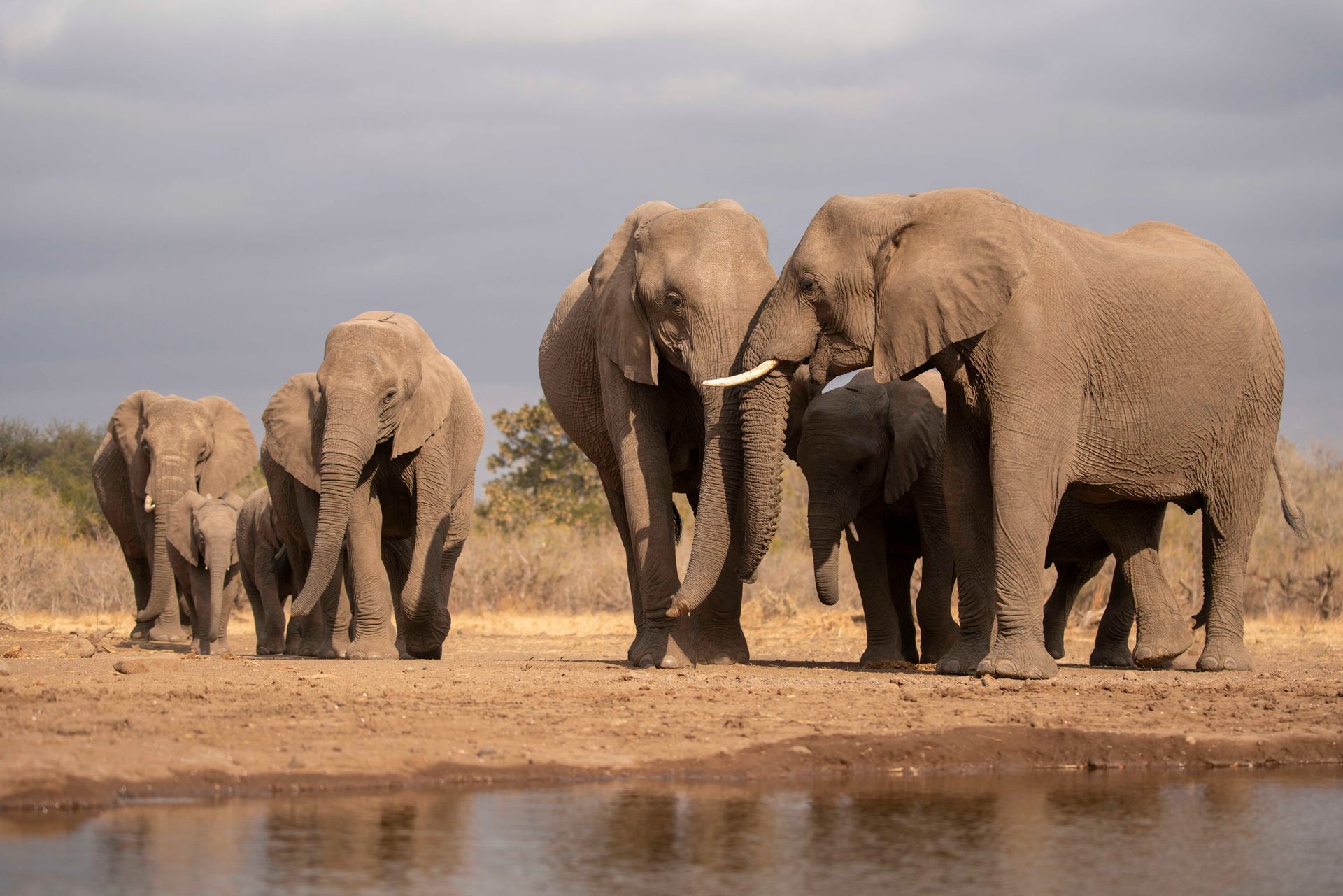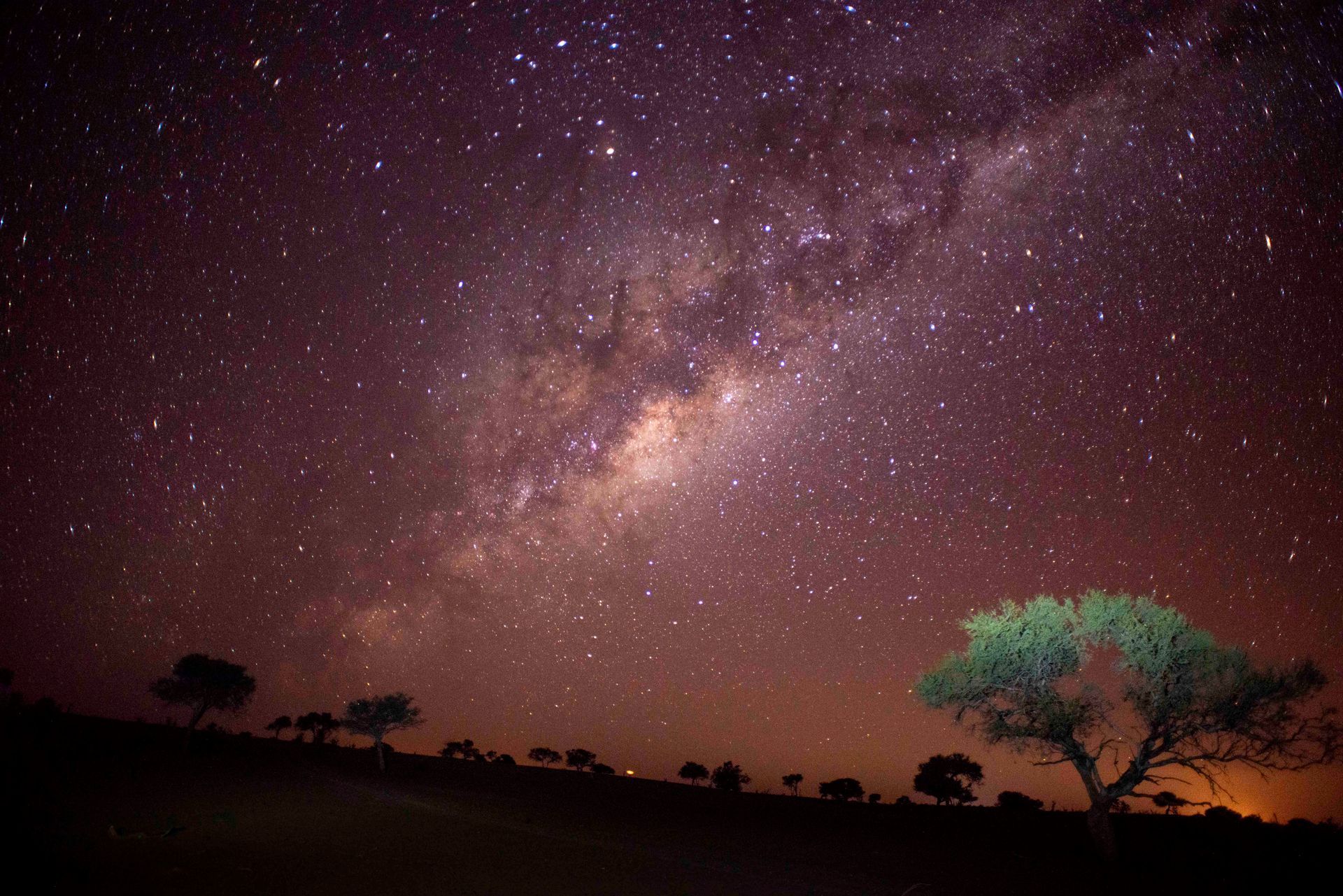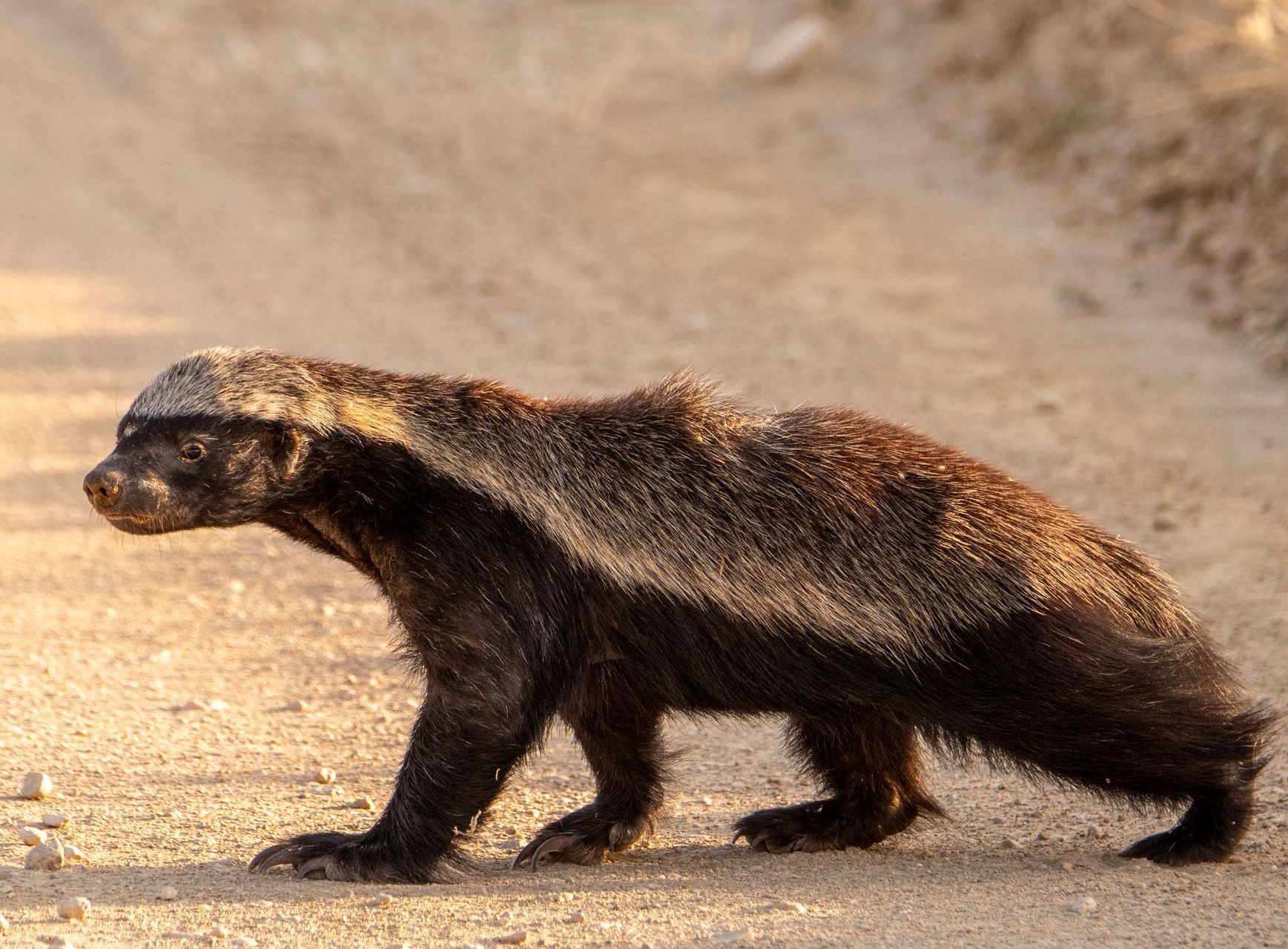Central Kalahari
Game Reserve
Central Kalahari
Game Reserve
Central Kalahari
Game Reserve
The heart of Botswana’s wilderness
The Central Kalahari Game Reserve (CKGR) is Botswana’s hidden epic – a landscape of immense scale, quiet power, and untamed beauty. Stretching across over 52,000 square kilometres, it’s the largest protected area in Southern Africa and one of the most remote reserves anywhere in the world.
Here, solitude is part of the experience. It’s a place for travellers who want to feel the silence, who want to stand beneath vast skies and witness life unfold in a place where nature still calls the shots.
Come summer rains, the Kalahari stirs. Grasses rise from the dust, antelope gather on open pans, and predators follow. Thunderclouds pile up along the horizon, turning golden at dusk as the heat gives way to astonishing sunsets.
This is no ordinary safari. It’s a journey into the wild heart of Botswana – into the roar of a black-maned lion, the hush of ancient salt pans, and the deep pulse of a land that has changed little in centuries.
The heart of Botswana’s wilderness
The Central Kalahari Game Reserve (CKGR) is Botswana’s hidden epic – a landscape of immense scale, quiet power, and untamed beauty. Stretching across over 52,000 square kilometres, it’s the largest protected area in Southern Africa and one of the most remote reserves anywhere in the world.
Here, solitude is part of the experience. It’s a place for travellers who want to feel the silence, who want to stand beneath vast skies and witness life unfold in a place where nature still calls the shots.
Come summer rains, the Kalahari stirs. Grasses rise from the dust, antelope gather on open pans, and predators follow. Thunderclouds pile up along the horizon, turning golden at dusk as the heat gives way to astonishing sunsets.
This is no ordinary safari. It’s a journey into the wild heart of Botswana – into the roar of a black-maned lion, the hush of ancient salt pans, and the deep pulse of a land that has changed little in centuries.
The heart of Botswana’s wilderness
The Central Kalahari Game Reserve (CKGR) is Botswana’s hidden epic – a landscape of immense scale, quiet power, and untamed beauty. Stretching across over 52,000 square kilometres, it’s the largest protected area in Southern Africa and one of the most remote reserves anywhere in the world.
Here, solitude is part of the experience. It’s a place for travellers who want to feel the silence, who want to stand beneath vast skies and witness life unfold in a place where nature still calls the shots.
Come summer rains, the Kalahari stirs. Grasses rise from the dust, antelope gather on open pans, and predators follow. Thunderclouds pile up along the horizon, turning golden at dusk as the heat gives way to astonishing sunsets.
This is no ordinary safari. It’s a journey into the wild heart of Botswana – into the roar of a black-maned lion, the hush of ancient salt pans, and the deep pulse of a land that has changed little in centuries.
Why it stands out
What makes the Central Kalahari truly special is its ability to surprise. Despite its reputation as desert, this ecosystem pulses with life. Herds of springbok, gemsbok and red hartebeest sweep across the grasslands, perfectly adapted to this arid realm. In their wake come cheetah – sleek, fast and thriving in the open spaces – and the iconic black-maned lions, whose size and power seem to match the enormity of the land itself.
By day, the horizon shimmers. By night, the bush comes alive with the calls of barking geckos, jackals and lion. There are few roads, even fewer people – just raw, breathtaking wilderness and the sense that you’re part of something ancient and enduring.
Why it stands out
What makes the Central Kalahari truly special is its ability to surprise. Despite its reputation as desert, this ecosystem pulses with life. Herds of springbok, gemsbok and red hartebeest sweep across the grasslands, perfectly adapted to this arid realm. In their wake come cheetah – sleek, fast and thriving in the open spaces – and the iconic black-maned lions, whose size and power seem to match the enormity of the land itself.
By day, the horizon shimmers. By night, the bush comes alive with the calls of barking geckos, jackals and lion. There are few roads, even fewer people – just raw, breathtaking wilderness and the sense that you’re part of something ancient and enduring.
Why it stands out
What makes the Central Kalahari truly special is its ability to surprise. Despite its reputation as desert, this ecosystem pulses with life. Herds of springbok, gemsbok and red hartebeest sweep across the grasslands, perfectly adapted to this arid realm. In their wake come cheetah – sleek, fast and thriving in the open spaces – and the iconic black-maned lions, whose size and power seem to match the enormity of the land itself.
By day, the horizon shimmers. By night, the bush comes alive with the calls of barking geckos, jackals and lion. There are few roads, even fewer people – just raw, breathtaking wilderness and the sense that you’re part of something ancient and enduring.
Some background
The Central Kalahari Game Reserve was established in 1961, originally as a sanctuary for the San people to continue their traditional way of life within their ancestral lands. Covering over 50,000 square kilometres, it remains one of the largest protected areas in Africa – a place where vastness, silence and survival still define the rhythm of life.
For decades, the reserve was closed to tourism, and even today, it retains an extraordinary sense of isolation. With few roads, minimal infrastructure and a stark, beautiful emptiness, the CKGR is one of the last true wildernesses in Southern Africa – a desert ecosystem ruled by weather and time.
The reserve’s landscape is dominated by ancient fossil riverbeds and open pans, which burst into life after the summer rains. These seasonal grasslands draw migratory herds of springbok, gemsbok and wildebeest, followed closely by predators like lion and cheetah. Despite the aridity, the Kalahari supports a surprising diversity of life – from meerkats and bat-eared foxes to kori bustards and brown hyenas.
The San communities who still live in and around the CKGR maintain a deep cultural connection to the land, carrying generations of ecological knowledge. Their presence is a vital part of this landscape’s story – a reminder that the Kalahari has always been both a wilderness and a home.
Some background
The Central Kalahari Game Reserve was established in 1961, originally as a sanctuary for the San people to continue their traditional way of life within their ancestral lands. Covering over 50,000 square kilometres, it remains one of the largest protected areas in Africa – a place where vastness, silence and survival still define the rhythm of life.
For decades, the reserve was closed to tourism, and even today, it retains an extraordinary sense of isolation. With few roads, minimal infrastructure and a stark, beautiful emptiness, the CKGR is one of the last true wildernesses in Southern Africa – a desert ecosystem ruled by weather and time.
The reserve’s landscape is dominated by ancient fossil riverbeds and open pans, which burst into life after the summer rains. These seasonal grasslands draw migratory herds of springbok, gemsbok and wildebeest, followed closely by predators like lion and cheetah. Despite the aridity, the Kalahari supports a surprising diversity of life – from meerkats and bat-eared foxes to kori bustards and brown hyenas.
The San communities who still live in and around the CKGR maintain a deep cultural connection to the land, carrying generations of ecological knowledge. Their presence is a vital part of this landscape’s story – a reminder that the Kalahari has always been both a wilderness and a home.
Some background
The Central Kalahari Game Reserve was established in 1961, originally as a sanctuary for the San people to continue their traditional way of life within their ancestral lands. Covering over 50,000 square kilometres, it remains one of the largest protected areas in Africa – a place where vastness, silence and survival still define the rhythm of life.
For decades, the reserve was closed to tourism, and even today, it retains an extraordinary sense of isolation. With few roads, minimal infrastructure and a stark, beautiful emptiness, the CKGR is one of the last true wildernesses in Southern Africa – a desert ecosystem ruled by weather and time.
The reserve’s landscape is dominated by ancient fossil riverbeds and open pans, which burst into life after the summer rains. These seasonal grasslands draw migratory herds of springbok, gemsbok and wildebeest, followed closely by predators like lion and cheetah. Despite the aridity, the Kalahari supports a surprising diversity of life – from meerkats and bat-eared foxes to kori bustards and brown hyenas.
The San communities who still live in and around the CKGR maintain a deep cultural connection to the land, carrying generations of ecological knowledge. Their presence is a vital part of this landscape’s story – a reminder that the Kalahari has always been both a wilderness and a home.
What kind of safari to expect
A safari in the Central Kalahari is not about ticking off a checklist – it’s about immersion. There are days when you’ll go hours without seeing another open safari vehicle. This is where the pace slows, the focus sharpens, and the small things – tracks in the sand, bird calls, the scent of wild sage – take on new meaning.
It’s ideal for second-time travellers to Botswana or seasoned safari-goers looking for a deeper connection to the wild. Accommodation ranges from mobile camps to intimate desert lodges, all designed to tread lightly on the land.
Cultural insight is another highlight. The CKGR is home to communities of San Bushmen, whose deep knowledge of the environment has been passed down over thousands of years. Guided walks and respectful interactions offer a window into this ancient way of life – a powerful complement to the reserve’s natural wonders.
What kind of safari to expect
A safari in the Central Kalahari is not about ticking off a checklist – it’s about immersion. There are days when you’ll go hours without seeing another open safari vehicle. This is where the pace slows, the focus sharpens, and the small things – tracks in the sand, bird calls, the scent of wild sage – take on new meaning.
It’s ideal for second-time travellers to Botswana or seasoned safari-goers looking for a deeper connection to the wild. Accommodation ranges from mobile camps to intimate desert lodges, all designed to tread lightly on the land.
Cultural insight is another highlight. The CKGR is home to communities of San Bushmen, whose deep knowledge of the environment has been passed down over thousands of years. Guided walks and respectful interactions offer a window into this ancient way of life – a powerful complement to the reserve’s natural wonders.
What kind of safari to expect
A safari in the Central Kalahari is not about ticking off a checklist – it’s about immersion. There are days when you’ll go hours without seeing another open safari vehicle. This is where the pace slows, the focus sharpens, and the small things – tracks in the sand, bird calls, the scent of wild sage – take on new meaning.
It’s ideal for second-time travellers to Botswana or seasoned safari-goers looking for a deeper connection to the wild. Accommodation ranges from mobile camps to intimate desert lodges, all designed to tread lightly on the land.
Cultural insight is another highlight. The CKGR is home to communities of San Bushmen, whose deep knowledge of the environment has been passed down over thousands of years. Guided walks and respectful interactions offer a window into this ancient way of life – a powerful complement to the reserve’s natural wonders.
Things to do and see
The sheer size of the CKGR makes exploration endlessly rewarding. Each corner has its own character and its own stories.
Deception Valley, once a riverbed, is now a wide, grassy basin that bursts with life after the rains. It’s one of the best areas for wildlife sightings, with antelope gathering in large herds and predators close behind.
Sunday Pan and Leopard Pan lie further north, drawing in big game and big cats. Lions are often seen here in the shade, while cheetah and even the occasional wild dog pass through on the hunt.
Passarge Valley offers some of the most beautiful open plains in the reserve – perfect for spotting cheetah, lion and brown hyena as they move silently across the landscape.
Further south, Piper’s Pan is remote and little-visited, but for those who make the journey, the rewards are great. This is one of the best places for encountering large herds of oryx and springbok, often with no other vehicles in sight.
Things to do and see
The sheer size of the CKGR makes exploration endlessly rewarding. Each corner has its own character and its own stories.
Deception Valley, once a riverbed, is now a wide, grassy basin that bursts with life after the rains. It’s one of the best areas for wildlife sightings, with antelope gathering in large herds and predators close behind.
Sunday Pan and Leopard Pan lie further north, drawing in big game and big cats. Lions are often seen here in the shade, while cheetah and even the occasional wild dog pass through on the hunt.
Passarge Valley offers some of the most beautiful open plains in the reserve – perfect for spotting cheetah, lion and brown hyena as they move silently across the landscape.
Further south, Piper’s Pan is remote and little-visited, but for those who make the journey, the rewards are great. This is one of the best places for encountering large herds of oryx and springbok, often with no other vehicles in sight.
Things to do and see
The sheer size of the CKGR makes exploration endlessly rewarding. Each corner has its own character and its own stories.
Deception Valley, once a riverbed, is now a wide, grassy basin that bursts with life after the rains. It’s one of the best areas for wildlife sightings, with antelope gathering in large herds and predators close behind.
Sunday Pan and Leopard Pan lie further north, drawing in big game and big cats. Lions are often seen here in the shade, while cheetah and even the occasional wild dog pass through on the hunt.
Passarge Valley offers some of the most beautiful open plains in the reserve – perfect for spotting cheetah, lion and brown hyena as they move silently across the landscape.
Further south, Piper’s Pan is remote and little-visited, but for those who make the journey, the rewards are great. This is one of the best places for encountering large herds of oryx and springbok, often with no other vehicles in sight.
Why choose the
Central Kalahari Game Reserve
This is one of Africa’s last true wilderness areas – vast, untouched and silent. It’s a land where big skies meet desert horizons, and where predators still rule the plains. Cheetah thrive here. Black-maned lions are seen at dusk and heard deep into the night. Herds of desert antelope move gracefully through the grasses.
It’s a destination best suited to those who have already fallen in love with Botswana and want to go deeper – or for travellers who long for stillness, space and raw, immersive nature. Add in the chance to walk with San Bushmen and learn from their millennia-old connection to the land, and you begin to understand why the Central Kalahari is unlike anywhere else.
If you’re seeking something rare – a safari that speaks to the soul – then this is your place. The Central Kalahari is Botswana at its wildest, its most powerful, and its most unforgettable.
Why choose the
Central Kalahari Game Reserve
This is one of Africa’s last true wilderness areas – vast, untouched and silent. It’s a land where big skies meet desert horizons, and where predators still rule the plains. Cheetah thrive here. Black-maned lions are seen at dusk and heard deep into the night. Herds of desert antelope move gracefully through the grasses.
It’s a destination best suited to those who have already fallen in love with Botswana and want to go deeper – or for travellers who long for stillness, space and raw, immersive nature. Add in the chance to walk with San Bushmen and learn from their millennia-old connection to the land, and you begin to understand why the Central Kalahari is unlike anywhere else.
If you’re seeking something rare – a safari that speaks to the soul – then this is your place. The Central Kalahari is Botswana at its wildest, its most powerful, and its most unforgettable.
Why choose the
Central Kalahari Game Reserve
This is one of Africa’s last true wilderness areas – vast, untouched and silent. It’s a land where big skies meet desert horizons, and where predators still rule the plains. Cheetah thrive here. Black-maned lions are seen at dusk and heard deep into the night. Herds of desert antelope move gracefully through the grasses.
It’s a destination best suited to those who have already fallen in love with Botswana and want to go deeper – or for travellers who long for stillness, space and raw, immersive nature. Add in the chance to walk with San Bushmen and learn from their millennia-old connection to the land, and you begin to understand why the Central Kalahari is unlike anywhere else.
If you’re seeking something rare – a safari that speaks to the soul – then this is your place. The Central Kalahari is Botswana at its wildest, its most powerful, and its most unforgettable.








